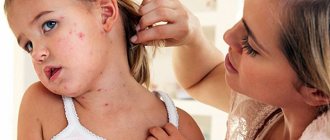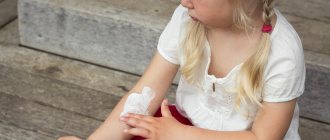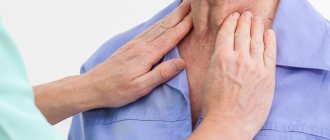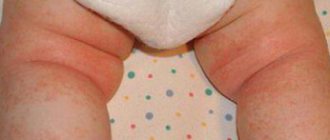December 3, 2020
Contact dermatitis is an inflammation of the skin in an area that has come into contact with an irritating substance or environmental factor. Children under 12 years of age are most susceptible to the disease. The point is the structural features of children's skin and the weakness of its protective mechanisms. The disease manifests itself in any area that has been in contact with the irritant, but more often on the face, arms, neck, and groin area.
If the provoking agent is recognized in time and the child is protected from it, the inflammation is well treated and the symptoms quickly pass. When the cause is difficult to identify or parents do not consult a doctor on time, the course of the disease becomes more severe.
Contact dermatitis occurs:
- simple - local irritation by some factor;
- allergic.
The second option will appear when the child has an increased sensitivity to this substance. The first interaction with it is outwardly unnoticeable, but chemicals are formed in the skin that bind to immune cells - T-lymphocytes. Immune cells remember the stimulus. Upon repeated contact, which can occur after a long time, T-lymphocytes trigger an allergic reaction and cause skin symptoms.
About the disease
Diaper rash is irritation of the baby's delicate skin due to mechanical friction or secretions (urine, feces).
The skin often suffers in natural folds (perineum and under the arms). Inflammation primarily occurs without infection, especially with a change in diet, which changes the properties of feces. However, due to the nature of children's skin, a bacterial or fungal infection can quickly develop, requiring immediate treatment. Diaper rash most often occurs in children who are bottle-fed, have excess body weight for their age, have digestive disorders, are prone to allergies, have lactase deficiency, and abnormal kidney development. Excessive wrapping, high room temperature, untimely bathing, prolonged stay in wet diapers or a diaper of the wrong size contribute to the development of diaper rash.
In practice, to select the correct treatment method, the following classification of diaper rash is used:
- diaper dermatitis - redness and rash appear only in those places that are constantly in contact with wet diapers;
- allergic ring - occurs around the anus due to a food allergy that develops to a new food product;
- seborrheic eczema - the skin of the lower abdomen and genitals becomes rough, swollen, oily to the touch, the border with normal skin is clear, looks like a hyperemic (bright red) huge spot;
- intertrigo - affects natural folds (gluteal, elbow, popliteal and others), against the background of redness, weeping cracks form, this condition is provoked by increased humidity;
- genital candidomycosis - occurs when a fungal infection is attached, has the appearance of red spotty rashes;
- impetigo - occurs when a pyogenic infection occurs; it first appears as separate and then small draining ulcers, which form crusts after drying. Impetigo in children forms on the buttocks.
Diaper rash at the initial stage can be eliminated with good care, changing the brand of diapers and using a high-quality baby skin cream. In severe cases, etiotropic treatment is required, aimed at combating the infectious onset.
Where do diaper rashes usually form? Under a diaper?
Problems usually appear in the folds of the skin, i.e. in places where moisture evaporation is difficult. The most comfortable place for diaper rash in a newborn is between the legs - in the groin area and between the buttocks, under the armpits. Also, diaper rash in a baby can form on the neck and between the toes.
As you can see, this disease manifests itself not only on the butt in a diaper. It can pop up unexpectedly anywhere. Diaper rash can even occur behind the ears, especially in newborns whose parents wear hats that are too thick and tight.
Diaper rash symptoms
Diaper rash is manifested by characteristic skin changes. From a practical point of view, the following 3 degrees of severity are distinguished:
- mild – the skin only turns red (hyperemia);
- medium - against the background of reddened skin, erosions, microcracks, and sometimes small ulcers are visible;
- severe - in addition to reddened skin and cracks, areas of erosion, ulcers are visible, the epidermis peels off in places. Almost always there is an infection, bacterial or fungal. An extreme manifestation of severe disease is microbial eczema, in which lesions are aggravated by an autoimmune process.
The baby's behavior with first-degree diaper rash does not change in any way; skin damage is detected when changing diapers. In the second degree, the child is bothered by burning, pain and itching, which is manifested by tearfulness, moodiness, anxiety, and poor sleep. The addition of a bacterial infection is manifested by an increase in body temperature, loss of appetite and other general symptoms.
How to recognize allergic contact dermatitis in a child
The contours of the inflammation often coincide with the outlines of the object that caused the irritation. The rash spreads little beyond the area of skin that came into contact with the causative factor. The skin here becomes red and swollen, very itchy, blisters, wounds and crusts appear.
Fungal and bacterial infections easily attach to wounds and suppuration occurs. Babies may experience an increase in general temperature.
Frequent exacerbation in the same places leads to unpleasant outcomes: areas of increased or decreased pigmentation, scars, thickening and roughening of the skin.
If you notice a rash or red spots on your child’s skin, be sure to see a doctor to get tests done to determine the exact cause and begin treatment.
The disease may worsen. To prevent this from happening, you need to find and eliminate the provoking causes.
Causes of diaper rash
Diaper rash occurs in almost every baby, even with ideal care.
This happens because the skin is the most vulnerable part of a baby’s body. Children's skin is thin and loose, its protective function is not fully formed. When soaked in liquid, the skin of children swells (macerates), which contributes to damage even with a slight touch. In children of the first year of life, the so-called water-lipid mantle is not sufficiently formed - the first skin barrier, a film on the stratum corneum of the epidermis. All other barriers - cellular, humoral - are also underdeveloped due to age. Therefore, babies are susceptible to local bacterial infection, which quickly spreads from the primary focus to the underlying skin.
The immediate cause is prolonged contact with moisture and ammonia salts, which are formed during the breakdown of urea. Feces contain enzymes (protease and lipase) that literally eat away at the skin. With diarrhea, diaper rash can develop within a few hours.
Some children's skin may react to certain components of baby cosmetics, a new brand of diapers, or other hygiene products. This does not mean that children's products contain low-quality components, it is just that the child has increased individual sensitivity to certain substances.
Treatment of diaper rash
Treatment methods depend on the severity and type of diaper rash.
In the first degree, you need to care for the baby more carefully and let the skin dry out. It is advisable to change diapers and diapers more often so that the baby's skin is not wet. When swaddling, it is advisable to wash the buttocks and genitals, especially after defecation, and allow the skin to dry naturally. After this, you need to lubricate the problem areas with baby cream. It’s good if the baby takes air baths (lying naked for a while). After an evening bath, you need to wait until the baby is completely dry and only then swaddle.
For more severe degrees of diaper rash, the following medications are used:
- drying;
- antiallergic;
- anti-inflammatory;
- wound healing;
- antiseptic.
By combining careful care and local medications prescribed by a doctor, it is always possible to cope with diaper rash in a short time.
How to avoid diaper rash?
Many diseases are easier to prevent than to cure, and diaper rash in a newborn is no exception. What to do to protect your baby from this scourge? Nothing complicated!
- Avoid situations where your child sweats:
- Monitor the temperature in the room. It is advisable that the thermometer does not rise above 18–20 degrees. This will significantly increase the chances of both avoiding diaper rash and protecting the baby from prickly heat.
- Refuse synthetics in favor of natural fabrics (cotton, linen).
- Try not to wrap your baby up.
- Minimize the risk of friction:
- Do not put tight clothes on your child.
- Avoid rough fabrics.
- Follow the rules of hygiene:
- Bathe your baby daily.
- Treat skin folds with protective cream or baby oil. Pay special attention to problem areas - under the arms, on the neck, in the groin, between the buttocks.
- After bathing, dry your baby's body with a towel, but do not rub him. In addition to regular textile towels, you can also use paper towels.
- To avoid diaper rash, use only products from reputable manufacturers.
- Change diapers regularly and do not forget about the benefits of air baths lasting about 10-15 minutes.
Prevention of diaper rash
Preventive measures are varied and based on centuries of experience in caring for an infant.
Everything that touches children's delicate skin should be natural, including fabrics and cosmetics. Synthetic items should be avoided. When bathing, you need to thoroughly rinse all folds. After each bowel movement, the baby is washed with warm water, sometimes several times in a row, until completely clean. Once or twice a week it is recommended to bathe in a weak decoction of string or chamomile. From time to time, all diapers and diapers need to be removed, giving the baby the opportunity to move his arms and legs freely, and the skin to “breathe.” If the first signs of inflammation appear on the skin, suspicious areas should be treated with a weak (pink) solution of manganese. Afterwards, do not wipe it off, but let it dry. The baby should be closely monitored, and if the inflammation does not go away within 1-2 days, contact a pediatrician. You should also pay close attention to complementary foods. It is unknown how the baby will react to the new product. The first fruit or vegetable complementary food should consist of only one vegetable or fruit. The same applies to cereals, dairy and meat products. You can mix products only after each individual product has been tested for tolerance. A new product should be given for the first time in a small portion (about 1 teaspoon) so as not to cause harm.
Powders and oils used for care should also be tried separately.
The pediatric doctors at the SM-Doctor clinic have extensive practical experience. Experts will advise you on the best care products and help you quickly get rid of diaper rash. Contact qualified pediatricians so that your baby can live an active and joyful life!
The most common dermatitis in children: features of diagnosis and therapy
According to foreign researchers, approximately 25% of all visits to doctors are complaints about skin pathology [1]. Among them, the most common dermatitis in children is seborrheic, contact (diaper) and atopic. In recent years, scientists have noted an increase in the incidence of these skin diseases in general practice. Thus, in the Netherlands, during the period 1987–2001, doctors most often diagnosed fungal (dermatophytoses), atopic, bacterial (impetigo) and contact dermatitis in children aged 0–17 years, which accounted for 57% of all cases of skin diseases [2].
Seborrheic dermatitis. The fungus Malassezia furfur is considered a possible etiological factor for seborrheic dermatitis. These microorganisms usually colonize healthy skin, but they also play an important role in the etiology and/or exacerbation of folliculitis, seborrheic and atopic dermatitis.
There are two clinical forms of the disease: seborrheic dermatitis of infants and seborrheic dermatitis of adults.
Seborrheic dermatitis affects 10% of boys and 9.5% of girls; more often - children aged the first 3 months of life, then the incidence decreases slightly (by 2 years it usually goes away or persists until 4 years of age). In adults, seborrheic dermatitis is diagnosed at any age: the rash is represented by red itchy papules covered with scales, on the scalp it resembles dandruff.
In infants suffering from seborrheic dermatitis, already at the 2-3rd week of life, accumulations of fatty, sebaceous scales (gneiss) appear on the skin of the scalp (to a lesser extent on the forehead, cheeks, in the folds behind the ears), and in cases of damage to large folds of the skin of the body and extremities - a maculopapular rash, also covered with scales on the periphery. The rash can also be localized in the area of the external auditory canal and sternum, on the neck, in the axillary and groin areas. Itching is moderate or absent [3]. When the rash is localized in the diaper area, a bacterial infection may occur, which sometimes makes treatment very difficult. If left untreated, the rash may spread to other areas of the body, becoming generalized. Against the background of seborrheic dermatitis or after its disappearance, some children develop another dermatitis - atopic, in the etiopathogenesis of which (especially the severe form of the disease) Malassezia furfur also plays a very significant role.
Important distinguishing signs of seborrheic dermatitis are the absence of itching of the skin, as well as the predominant lesion of the scalp and diaper area in children suffering from seborrheic dermatitis. Atopic dermatitis is characterized by skin exudation, while seborrheic dermatitis is characterized by an earlier onset and the absence of a hereditary burden of atopy (Table 1).
Treatment of seborrheic dermatitis is not particularly difficult. Manifestations of the disease in the scalp in newborns (milk crusts) can spontaneously go away by the 6-8th week of life (or for such children it is enough to prescribe daily washing of the hair with a special shampoo, followed by the application of mineral or olive oils). They also cleanse irritated skin with areas of hyperseborrhea, especially in problem areas. For this purpose, the use of cleansing gel “Bioderma Sensibio DS”, “Saforel” is recommended, “Topicrem” is also recommended, shower gel foam is for skin prone to mycoses, “Friderm Zinc” (for flaking of the scalp).
After preliminary cleansing, the skin is dried and a dermatological cream (for example, Bioderma Sensibio DS) is applied to problem areas (in newborns and children - scalp, forehead, buttocks; in adults - wings of the nose, eyebrows, chin).
Of the dermatological shampoos specially designed for the treatment of seborrheic dermatitis in children and adults, Nizoral shampoo containing 2% ketoconazole is widely used. However, the same clinical improvement in a comparative study was noted with the use of Kelual DS shampoo, which has fungicidal, fungistatic, anti-inflammatory and keratoregulating effects due to the content of the non-imidazole antifungal drug ciclopiroxolamine (D. Shuttleworth et al., 1998). Cyclopiroxolamine has a high coefficient of fungistatic action (suppression of proliferation of Malassezia fungi); in addition, it has a unique anti-inflammatory effect, comparable even to the effect of a mild corticosteroid (K. Gupta, 1998). The composition of the Kelual DS shampoo also includes another antifungal drug - zinc pyrithione 1%, which has a fungistatic and kerator-reducing effect. The combination of two antifungal active components has a synergistic effect in suppressing the proliferation of Malassezia fungi, which is reflected in the high coefficient of fungistatic action in the Kelual DS shampoo, which, as the study has shown, is superior to the inhibitory activity of ketoconazole. Additionally, the Kelual DS shampoo contains keluamide, which has a mechanical dispersive effect, ensuring rapid elimination of squams (keratolytic effect).
In case of the formation of seborrheic crusts on the head and severe peeling of the skin, you can also use the Friederm Tar shampoo, Mustela Stelaker Cream (apply it to seborrheic crusts in children, leave it overnight and then wash it off with Mustela Bebe Foam Shampoo for newborns).
Typically, medicated shampoos are used 2 times a week, the course of treatment is 6 weeks.
Other nonpharmacologic approaches (eg, limiting the use of hair sprays and gels, exposure to sunlight) may also be helpful in older children and adolescents.
For seborrheic dermatitis, topical corticosteroids should be avoided as first-line treatment [4]. Recently, a report appeared on the high therapeutic activity of the combined use of antifungal shampoo (ketoconazole) and the topical calcineurin inhibitor tacrolimus (currently in Russia this series of non-steroidal anti-inflammatory drugs is represented only by Elidel cream (pimecrolimus 1%)) [5].
In recent years, Malassezia furfur has been considered not only as a trigger factor for atopic dermatitis in children and adults, but also as one of the causes of severe recurrent course of the disease, refractory to traditional therapy. Also, these microorganisms are more often detected in this variant of atopic dermatitis, when the skin process is localized on the head, neck and chest area (in the English literature, the so-called head and neck dermatitis - “dermatitis of the neck and head”).
Atopic dermatitis. Spergel and Paller provide the following clinical criteria for atopic dermatitis [6].
Mandatory criteria:
- itching;
- eczematous changes: chronic or recurrent; the most age-specific patterns involve the face, neck, and extensor surfaces of the extremities in infants and children; Damage to the flexor surfaces, especially in older children and adults, is less pronounced in the groin and axillae.
Important features in favor of this diagnosis (not found in all patients):
- onset of the disease at an early age;
- xerosis;
- atopy (IgE reactivity).
The diagnosis of atopic dermatitis can be made after excluding diseases such as scabies, allergic contact dermatitis, seborrheic dermatitis, psoriasis and ichthyosis.
As practice shows, atopic dermatitis is characterized by clinical polymorphism. Suffice it to say that the literature describes more than 26 separate locations of the skin process on parts of the body and nine typical signs of the disease, the main of which, in combination with dry skin, are three: itching, erythema, papules. However, the location of skin lesions often depends on age. Thus, in infancy (the onset of the disease before 2 years of age) the cheeks, face, neck, and outer surface of the limbs are affected. In the age period from 2 to 10 years, rashes are usually localized in the elbow and popliteal folds, on the back, back of the neck, and lateral surfaces of the torso. Adolescents and adults are characterized by damage to the face (mainly periorbital or atopic cheilitis), the dorsum of the hands, and in the area of the elbows and knees. Itchy papules are located against the background of lichenized and dry skin, often with pronounced peeling.
Today, external therapy is recognized as the most important, pathogenetically substantiated and absolutely necessary for every patient with atopic dermatitis, which includes proper skin care (cleansing/moisturizing/softening) followed by the application of anti-inflammatory drugs to it. According to the American prof. D. Leung, “moisturizing and softening the skin are key in the treatment of atopic dermatitis” [7]. Moreover, due to impaired barrier function and dry skin, moisturizers/emollients should be used even during periods of the disease when there are no symptoms [7, 8]. This approach is based on scientific data: in particular, in patients with atopic dermatitis, the same inflammatory cells that infiltrate the lesions are found in unaffected areas of the skin; in addition, the manifestations of skin hyperreactivity and xerosis in different areas of the skin are no different [7, 8]. Because of its hyperreactivity, atopic skin has the ability to change depending on fluctuations in air temperature, stressful situations, after eating certain foods, or for other unknown reasons. The condition of the skin also changes after applying external medications; Sometimes patients or doctors themselves can associate symptoms such as burning, increased itching, hyperemia with the external agent used, which often leads to discontinuation of the drug. In fact, the cause may be the above exogenous factors. If necessary, the doctor conducts a drug tolerance test on the patient. Rare cases of the development of allergic contact dermatitis even to the main anti-inflammatory drugs for the treatment of atopic dermatitis (topical corticosteroids or topical calcineurin inhibitors) have been described. Another feature of atopic skin is that its dryness, accompanied by transepidermal water loss, increases the systemic absorption of external hormonal agents and, consequently, their side effects [9].
Accordingly, effective treatment of dry and itchy skin may improve treatment outcomes for atopic dermatitis. However, it is impossible to influence such causes of dry skin as changes in the stratum corneum, disturbances in keratinization, the composition of the balance and amount of intracellular lipids, metabolism of transepidermal water, changes in skin pH, etc. simply by applying moisturizers and/or emollients to the skin. These are very complex physicochemical, biochemical and pathophysiological processes that occur differently in skin diseases. Recently, scientists have been considering dry skin in atopy from the point of view of a unified pathophysiological concept “atopy, dry skin and the environment” [10, 11]. Recognizing the importance of this approach, the dermatocosmetic lines “A-Derma”, “Dardi Lipo Line” were created, as well as a new unique emollient, which is used with great success in the treatment of atopic dermatitis abroad - “MAS063D” (Atopiclair) [12, 13]. Thus, according to Abramovits et al., in 94% of patients with mild to moderate atopic dermatitis, the need for topical corticosteroids completely disappeared within 50 days after using the non-steroidal hydrolipidic cream “MAS063D” (Atopiclair) [13].
The unique line of products “A-Derma” (“Egzomega”) uses the exceptional qualities of the oat extract of the Realba variety: amylose, amylopectin and β-glycans included in “Egzomega”, coming into contact with water, form a moisturizing and protective film on the surface of the epidermis . In addition, they promote the retention of lipids, polyphenols and proteins, forming a micelle “reservoir” that releases active substances as needed and provides prolonged action; proteins have an anti-inflammatory effect; phospholipids and glycolipids nourish and moisturize the skin; polyphenols have antiradical and anti-inflammatory effects; magnesium, iron, copper, zinc, manganese are protein cofactors. Egzomega products also contain essential omega-6 fatty acids and vitamin B3, which ensures the restoration of the structure and barrier function of the skin.
To care for the skin of patients with atopic dermatitis, other products from the medical and cosmetic series such as “Aven”, “Mustela Stelatopia”, “Uriage”, “Vichy”, etc. are also widely used.
Before using emollients/moisturizers, a patient with atopic dermatitis should comply with certain skin care conditions (cleansing with special hygiene detergents, using dechlorinated water, etc.). Moisturizers/emollients are applied after preliminary cleansing of the skin using medicated skin care products - usually the same line of medicinal cosmetics (Topicrem Bodygel, BioEcolie; Mustela Stelatopia, washing cream; Egzomega - cleansing shower oil for atopic skin, etc.).
In case of persistently recurrent course, as well as moderate and severe forms of atopic dermatitis, patients are advised to use medicinal cosmetics containing additional anti-inflammatory (for example, alphabisabolol, allantoin, dexpanthenol, etc.) or antifungal substances (for example, “Topicrem” gel - foam for body skin prone to mycoses, which contains piroctone olamine 1%).
In particular, the use of the Topicrem cosmetic line is recommended (Table 2).
The Dardia Lipo Line treatment products include natural hydrophilic substances - lactate, urea and glycerin, while cetearylethyl hexanoate and a mixture of medium chain triglycerides maintain the lipid balance of the skin. The combination of these components leads to the achievement of the best results in the maintenance therapy of allergic dermatoses, preventive skin care after the use of topical corticosteroids, chemotherapy and radiation, as well as in daily skin care. The water-fat and anhydrous forms of the products in this line are ideal for dry and very dry skin, are easily absorbed and evenly distributed over the skin (Table 3).
It has been proven that the effectiveness of moisturizers/emollients depends on the dose (they should be used regularly in sufficient quantities), skin pH, and also on patient compliance [7, 8, 12, 13]. It is especially important to use them before applying anti-inflammatory drugs to the skin (topical corticosteroids, topical calcineurin inhibitors). There are even cases in the literature of equivalent effectiveness of moisturizers and topical corticosteroids in patients with atopic dermatitis. In general, skin hydration and moisturizers significantly increase the effectiveness of complex therapy for atopic dermatitis and the quality of life of such patients. In addition, moisturizing preparations have a kind of preventive effect even before the appearance of pronounced symptoms of exacerbation of the disease and can significantly reduce the amount of drug therapy. At the same time, they do not replace topical drugs that have an anti-inflammatory effect.
Modern practice shows that the importance of using moisturizers in the treatment of atopic dermatitis is significantly underestimated throughout the world. Thus, a recent survey showed that of 77% of children suffering from atopic dermatitis to whom specialists prescribed emollient ointments, only 21% used them immediately after washing [14].
The goal of the treating physician and nurses is to instruct patients with atopic dermatitis and their caregivers to regularly cleanse and hydrate the skin, followed by the application of an anti-inflammatory drug if necessary.
Sometimes in children under one year of age, the diagnosis of atopic dermatitis presents certain difficulties, especially if the skin manifestations are localized in the diaper area. Diaper dermatitis almost always occurs in the buttocks area. The disease is associated with factors such as the immaturity of the protective mechanisms of the child’s skin, its mechanical damage (friction from diapers) and chemical irritation from urine and feces. Depending on the severity, the clinical manifestations of diaper dermatitis can vary from mild skin erythema of varying prevalence to the appearance of papules, erosions and infiltrates in the skin folds. Severe diaper dermatitis is characterized by the appearance of conflicts, then erosions and crusts on the surface of the papules.
In some children suffering from diaper dermatitis or seborrheic dermatitis, signs of atopic dermatitis can also be detected at the same time.
In the treatment of diaper dermatitis, the use of medicinal hygiene products is justified (Bepanten, Topicrem ultra-moisturizing emulsion, Mustela Stelkactive diaper cream, etc.), which are applied only after preliminary cleansing of the skin with special hygiene products. Air baths are important. The use of topical corticosteroids in the treatment of diaper dermatitis is unjustified. In addition, when prescribing a topical combination drug, the doctor must be sure of its necessity, i.e., correctly determine the indications for its use. Thus, according to American researchers, if a child has diaper dermatitis, most doctors considered it more appropriate to use a combination drug consisting of a strong class topical corticosteroid (Betamethasone valerate) and an antifungicide (clotrimazole), explaining this by the fact that the basis of diaper dermatitis is candidiasis and inflammatory mechanisms [15]. At the same time, doctors forgot that this topical corticosteroid is contraindicated for use in children under 12 years of age. Moreover, as another study showed, every second pediatrician (56%) prescribed a similar drug to children aged 0 to 4 years [16].
The International Expert Group on Atopic Dermatitis (2006) recalls that in adult patients with atopic dermatitis, a combination of atopic, contact and irritative dermatitis may be observed, and atopic dermatitis involving the hands and feet should be differentiated from psoriasis of the palms and soles and fungal skin lesions [8 ]. It is also necessary to remember about such rare pathologies in children as genodermatosis - Neferton syndrome; in adults and children - vitamin deficiency, malignant skin tumors. Thus, mycosis fungoides, by the nature of the skin lesions and the presence of intense itching, may be similar to the common form of atopic dermatitis, however, mycosis fungoides appears in adolescence and adulthood [7, 8].
For questions regarding literature, please contact the editor.
D. Sh. Macharadze , Doctor of Medical Sciences, Professor of RUDN University, Moscow










